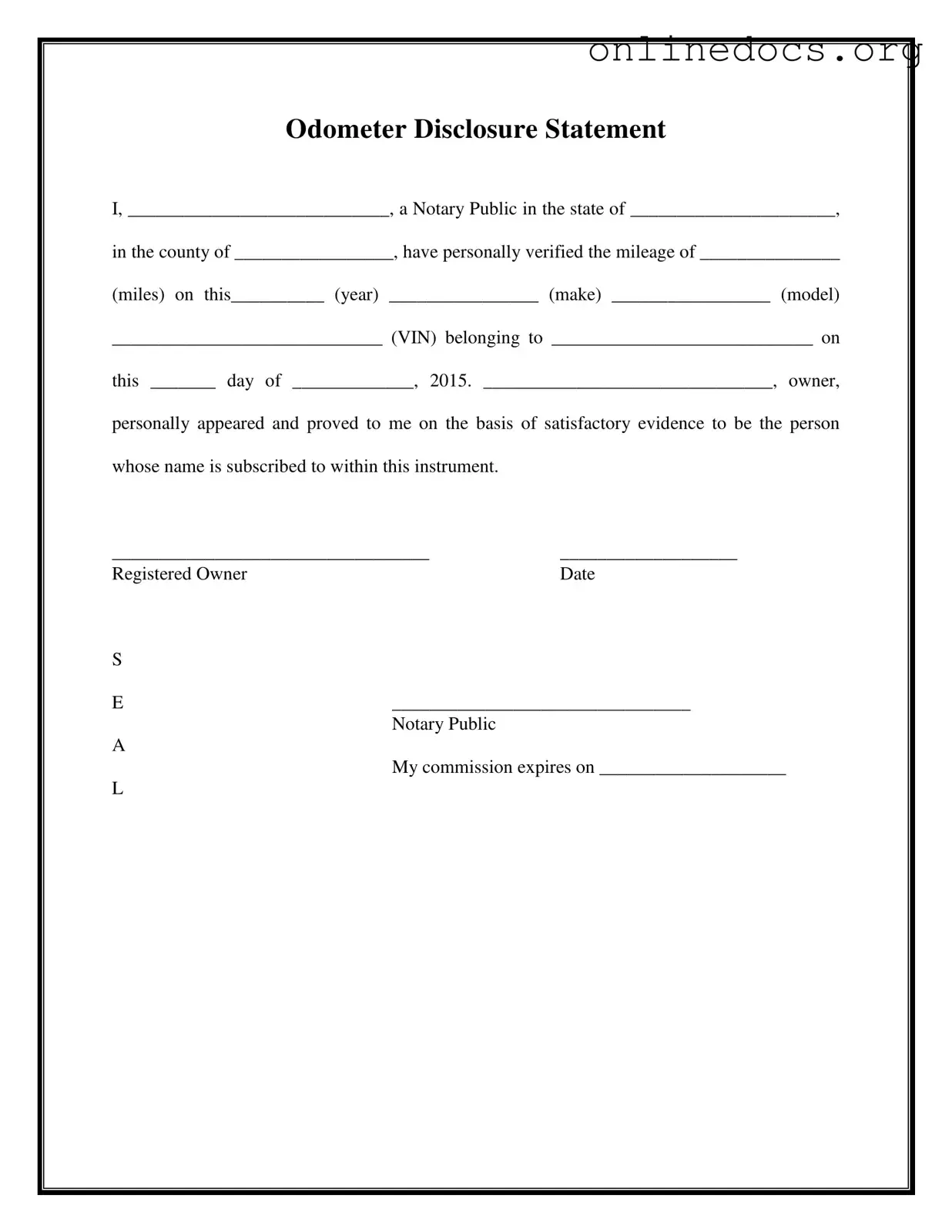The Bill of Sale serves as a legal document that outlines the transfer of ownership of a vehicle from one party to another. It typically includes details such as the buyer's and seller's names, the vehicle identification number (VIN), and the sale price. Similar to the Notarized Odometer Statement, the Bill of Sale provides essential information about the vehicle and serves as proof of the transaction. Both documents are often required when registering a vehicle with the Department of Motor Vehicles (DMV).
The Vehicle Title is another critical document related to vehicle ownership. It serves as the official record of ownership and must be transferred when a vehicle changes hands. Like the Notarized Odometer Statement, the Vehicle Title may require a signature from the seller and can include odometer readings at the time of sale. Both documents help to ensure that ownership is clear and legally recognized.
The Application for Title is a form submitted to the DMV when an individual seeks to obtain a title for a vehicle. This document may require information similar to that found in the Notarized Odometer Statement, such as the VIN and odometer reading. Both documents are essential for establishing legal ownership and ensuring that the vehicle's history is accurately recorded.
The Release of Liability form is used by sellers to inform the DMV that they are no longer responsible for a vehicle once it has been sold. This document protects the seller from any future liabilities associated with the vehicle. Similar to the Notarized Odometer Statement, it requires the seller's information and details about the vehicle, ensuring that the transaction is officially recognized.
The Vehicle Registration form is required for all vehicles operating on public roads. This document includes important details about the vehicle, such as the owner's name and address, and often requires information about the odometer reading. Both the Vehicle Registration form and the Notarized Odometer Statement serve to document important vehicle information for legal and regulatory purposes.
The RV Bill of Sale is a critical document for the sale of recreational vehicles, ensuring that the transaction is well-documented and legally binding. This form captures essential details such as the buyer and seller's information, the vehicle's description, and the agreed purchase price, thus offering security and clarity to both parties involved. For those seeking templates to create a properly formatted RV Bill of Sale, resources like legalformspdf.com can be invaluable.
The Power of Attorney form allows one individual to act on behalf of another in legal matters, including vehicle transactions. This document can be used when the owner cannot be present to sign the necessary paperwork for a vehicle sale. Similar to the Notarized Odometer Statement, it must be properly executed to ensure that the authority granted is legally binding.
The Affidavit of Ownership is a sworn statement used to declare ownership of a vehicle, particularly in situations where the title is lost or unavailable. This document may require similar information to the Notarized Odometer Statement, such as the VIN and odometer reading, to confirm ownership and vehicle details. Both documents aim to clarify ownership and facilitate the transfer process.
The Notice of Transfer and Release of Liability is a document filed with the DMV to notify them of a vehicle's sale. It serves a similar purpose to the Release of Liability form but may include additional information about the transaction. Both documents help protect the seller from future liabilities and ensure that the DMV has accurate records of vehicle ownership.
The Vehicle History Report provides detailed information about a vehicle's past, including ownership history, accident reports, and odometer readings. While it differs in purpose, it shares the common goal of ensuring transparency and accuracy regarding a vehicle's history. Like the Notarized Odometer Statement, it can be crucial for potential buyers to make informed decisions.
The Odometer Disclosure Statement is a specific form required by federal law when a vehicle is sold. It documents the odometer reading at the time of sale and is similar to the Notarized Odometer Statement in that it serves to prevent odometer fraud. Both documents are essential for maintaining accurate vehicle records and protecting buyers from misleading information.
